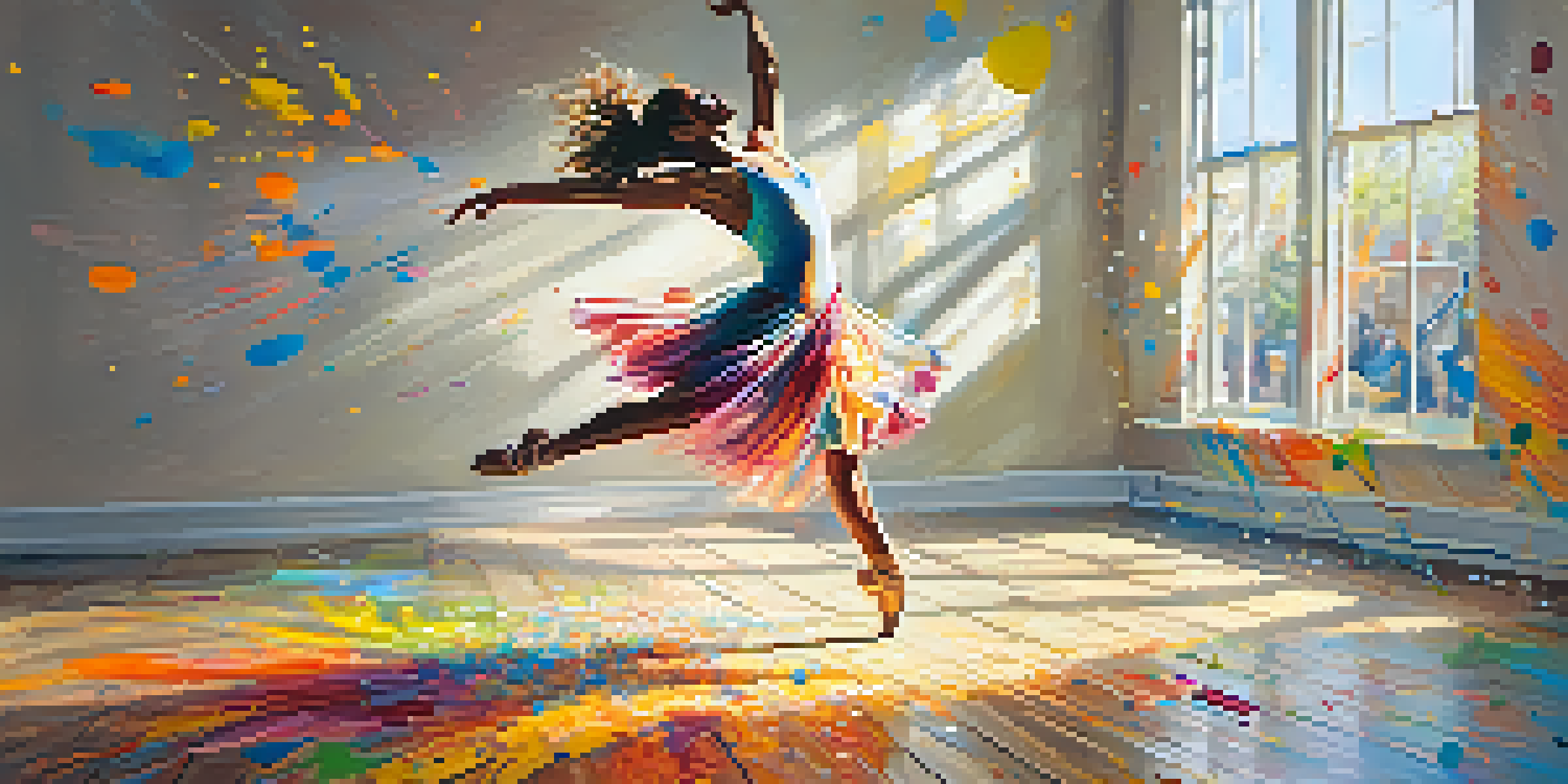Movement and Emotion: The Neurobiology of Dance Expression

The Intricate Connection Between Movement and Emotion
Movement and emotion are deeply intertwined, with each influencing the other in profound ways. When we dance, our bodies express feelings that words often cannot capture. Think of how a joyful leap can embody happiness, while a slow, heavy sway might mirror sadness. This connection is not just artistic; it has a grounding in our neurobiology.
Dance is the hidden language of the soul.
Studies show that specific movements activate different emotional responses in the brain. For instance, fast-paced, energetic choreography can elevate mood and energize the dancer, while more fluid, gentle movements can induce relaxation and introspection. This suggests that our brain responds to physical expression much like it does to emotional stimuli, creating a feedback loop that enhances our emotional experience.
Understanding this connection can help us harness the power of dance as a therapeutic tool. Dance therapy, for example, utilizes movement to process emotions and foster healing. By recognizing how movement impacts our emotional state, we can better appreciate the role of dance in personal expression and mental well-being.
Neurobiology: How Dance Affects Our Brain Chemistry
When we engage in dance, our brain releases a cocktail of chemicals that significantly influence our emotions. Key players include dopamine, which is often called the 'feel-good' neurotransmitter. This is why a good dance session can leave us feeling elated and invigorated, much like a runner experiences a 'runner's high'.

Moreover, dance also stimulates the release of endorphins, which help reduce stress and anxiety. When we move rhythmically to music, our bodies produce these natural painkillers, creating a sense of euphoria. This physiological reaction underscores why so many people turn to dance not only for fun but also as a coping mechanism during challenging times.
Movement Influences Emotions
Dance serves as a powerful expression of emotions, with movements reflecting feelings that words often cannot convey.
Additionally, the social aspect of dance can amplify these effects. Dancing with others fosters a sense of community and connection, which can lead to increased oxytocin levels—the 'bonding hormone'. This bond can create a powerful emotional experience that enriches our dance journey and enhances our overall mental health.
The Role of Mirror Neurons in Dance Expression
Mirror neurons are fascinating brain cells that fire both when we act and when we observe someone else performing an action. This means that when we watch a dancer express emotions through their movements, our brains can simulate that experience. It’s as if we are dancing alongside them, feeling the same emotions they portray.
To watch us dance is to hear our hearts speak.
This phenomenon plays a crucial role in empathy, helping us connect with the emotions of others. When we see a dancer express joy, sadness, or frustration, our mirror neurons allow us to resonate with those feelings, creating a shared emotional experience. This is why dance can be such a powerful medium for storytelling and human connection.
In practical terms, this means that when we engage with dance—either as participants or observers—we are not only processing our emotions but also tapping into a collective emotional experience. This connection can be incredibly healing, making dance a universal language that transcends cultural and linguistic barriers.
How Different Dance Styles Evoke Unique Emotions
Dance is a diverse art form, with each style capable of evoking a distinct emotional response. For instance, ballet often conveys grace and elegance, while hip-hop might express energy and defiance. Each genre tells its own story, tapping into different aspects of the human experience.
Take salsa, for example; its upbeat tempo and intricate footwork can spark feelings of joy and excitement. In contrast, contemporary dance might explore deeper themes of vulnerability and introspection. The choice of style can significantly influence not only the dancer's emotional expression but also how the audience perceives and connects with the performance.
Dance Enhances Brain Chemistry
Engaging in dance releases neurotransmitters like dopamine and endorphins, promoting feelings of joy and reducing stress.
Understanding these emotional nuances can enhance our appreciation of dance. It encourages us to explore different styles and recognize the diverse emotions they can evoke. By experiencing various forms of dance, we can deepen our emotional intelligence and empathy, ultimately enriching our understanding of ourselves and others.
Dance as a Tool for Emotional Regulation
Many people find dance to be an effective form of emotional regulation. When we feel overwhelmed or stressed, moving our bodies can help release pent-up emotions and restore balance. This process allows us to channel feelings into movement, which can be incredibly cathartic.
Engaging in dance can also serve as a mindfulness practice, drawing us into the present moment. As we focus on our movements and the rhythm of the music, we can temporarily set aside worries and distractions. This mindful approach can enhance our emotional resilience, allowing us to cope better with life's challenges.
Furthermore, dance can help us articulate emotions that might be difficult to express verbally. For those who struggle with communication, moving to music can provide an outlet for feelings that are otherwise trapped. This expression can lead to increased self-awareness and emotional clarity, ultimately empowering individuals on their personal journeys.
The Therapeutic Benefits of Dance in Mental Health
The therapeutic benefits of dance have gained recognition in mental health settings. Dance therapy integrates movement with psychological and emotional healing, offering a unique approach to treatment. It encourages individuals to express themselves freely, tapping into emotions that may be difficult to articulate.
Participants in dance therapy often report improvements in mood, self-esteem, and overall emotional well-being. The combination of physical movement and emotional expression creates a safe space for individuals to explore their feelings. This holistic approach allows for deeper healing, addressing both the body and mind.
Dance as Emotional Regulation Tool
Many find dance to be an effective way to regulate emotions, offering a cathartic release and enhancing mindfulness.
Moreover, dance therapy can be particularly beneficial for those dealing with trauma. Movement can help release stored emotions and facilitate processing in a supportive environment. As individuals learn to express their emotions through dance, they can reclaim their agency and foster resilience in their healing journey.
Conclusion: Embracing Dance as an Emotional Expression
In conclusion, the intricate relationship between movement and emotion reveals the powerful role that dance plays in our lives. From enhancing our brain chemistry to fostering social connections, dance is a multifaceted form of expression that resonates deeply with our emotions. It’s a universal language that transcends barriers and unites us in our shared human experience.
As we embrace dance as a tool for emotional expression and healing, we open ourselves to new possibilities for growth and connection. Whether through structured dance therapy or spontaneous movement in our living rooms, the act of dancing can offer profound benefits for our mental and emotional well-being.

So, next time you feel the urge to move, whether it’s a joyful twirl or a slow sway, remember that you’re tapping into something far greater than just rhythm. You’re engaging in a beautiful dialogue between your body and emotions—one that can lead to deeper understanding and healing.